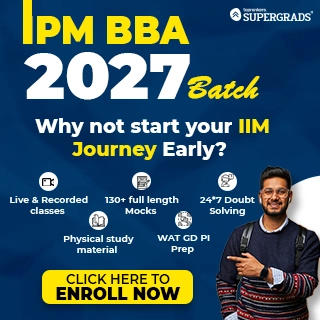IPMAT Previous Year Question Papers With Solution Download PDF
December 17, 2025
Overview: IPMAT previous year question papers are crucial for understanding question types, difficulty level, and topic weightage. But for IPMAT, they’re even more valuable — read on to discover why they’re the key to cracking the exam.
IPMAT Indore, famously, does not reveal its exam pattern in advance. This means that students must rely on IPMAT previous year question papers of the entrance exam to understand the scope and structure of the IPM aptitude test.
In this article, we’re going to look at:
- Why practicing IPMAT PYQ is beneficial in several ways,
- Some of IPMAT previous year papers with solution PDFs,
- A few sample questions and IPMAT mocks to ace your preparations.
Let’s get started with the IPMAT Previous Year Question Papers with Answers:
Table of Contents
- IPMAT Indore Previous Year Question Papers
- IPMAT Rohtak Previous Year Question Papers
- JIPMAT Previous Year Papers
- Benefits of Solving IPMAT Previous Year Question Papers
- IPMAT Sample Questions for Quantitative Ability - MCQ
- IPMAT Sample Questions for Quantitative Ability - SA
- IPMAT Sample Questions for Verbal Ability
- IPMAT Sample Questions for Logical Reasoning and Data Interpretation
- Tips to Prepare with IPMAT Previous Year Papers
IPMAT Previous Year Question Papers Overview
Before checking the IPMAT PYPs, lets take an overview of it.
Here's how the IPMAT exam has evolved over the years:
- In 2023 and 2024, the IPMAT Indore exam featured 90 questions. These questions are divided into 3 sections: Quantitative Aptitude (Short Answer) has 15 questions, Quantitative Aptitude (MCQ) has 30 questions, and Verbal Ability consists of 45 questions.
- In 2023, the Quantitative Aptitude (MCQ) section was moderate. In 2024, the same section had a higher level of difficulty, which can be described as being 'moderate to difficult'.
- Quantitative Aptitude (SA) has gone from being moderate in 2023 to easy in 2024, according to analysis done by SuperGrads' experts.
- IIM Indore slightly increased the difficulty level of the Verbal Ability section in 2024 compared to 2023's exam, making it moderate to easy.
IIM Indore IPMAT Previous Year Question Papers PDF
IIM Rohtak IPMAT Previous Year Question Papers PDF
JIPMAT Question Papers PDF
Download: JIPMAT Previous Year Papers
Here's Why Practicing with IPMAT Previous Year Question Papers is Key!
Solving the previous year question paper of IPMAT Indore is a great way to learn more about the expectations of the exam.
Even better, you learn how to enhance your preparation to achieve it. But that’s not all.
There are a lot of ways this practice can benefit you:
- Understanding the exam pattern: The IPMAT exam pattern changes slightly every year, so solving the IPMAT previous year question papers with solutions can help you get a good idea of the format, syllabus and the types of questions asked in the exam.
- Identifying important topics: By analyzing question papers of IPMAT exam, you can identify the important IPMAT topics and questions that are likely to be repeated in the exam. This can help you prioritize your study plan and focus on the topics that carry more weightage.
- Getting familiar with the style of questions: The IPMAT exam often features tricky and unconventional questions, so practicing with question papers for IPMAT exam can help you get familiar with the style of questions asked in the exam.
- Improving time management skills: The IPMAT exam has a strict time limit, and solving IPMAT last year question papers can help you improve your time management skills. By practicing regularly, you can learn to manage your time effectively and allocate the right amount of time to each question.
- Building confidence: Solving IPMAT previous year question papers can help you build confidence and reduce exam stress. It can help you become familiar with the exam format and feel more comfortable while taking the actual exam.
So there you have it, folks. Practicing with previous year sample paper of IPMAT is the way to go if you want to ace the IPMAT exam.
Get practicing and you'll be well on your way to success!
Sample Questions from IPMAT Previous Year Question Papers with Solution PDF
IPMAT Sample Questions with Solutions for Quantitative Ability (MCQ) Section
Following IPMAT Maths Preparation Tips can help clear all your basics and help plan your preparations wisely.
Q) A boy multiplied 987 by a certain number and obtained 559981 as his answer. If in the answer, both 9 and 8 are wrong and the other digits are correct, then the correct answer would be:
- a) 553681
- b) 555181
- c) 555681
- d) 556581
Ans: C
Q) The odds against a specific event P are 7:4, and the odds in favor of another event Q independent of P are 8:7. The probability that at least one of the events will happen is:
- a) 11/165
- b) 59/165
- c) 116/165
- d) 118/165
Ans: C
Q) The remainder when 75 3 is divided by 37:
- a) 0
- b) 1
- c) 5
- d) 7
Ans: B
Q) If f(x)+f(1+x)+f(2+x)=2x for all real values of x, and f(0)=1, then find the value of f(4)?
- a) 4
- b) 5
- c) 6
- d) 7
Ans: B
Q) Find the equation of the straight line that passes through the points (1,2) and (7,8)
- a) x+y=1
- b) x-y=1
- c) x+y=0
- d) x-y+1=0
Ans: D
IPMAT Sample Questions with Solutions for Quantitative Ability (SA) Section
Here are some samples of the type of questions that can be asked in the Quantitative Ability (Short Answer) section:
Q) a, b, c, d are digits 1, 3, 5, or 7, with each digit used only once. How many different values of aXb+ cXd can be obtained?
- a) 9
- b) 6
- c) 3
- d) 12
Ans: C
Q) Mohit drew a complex polygon and calculated the sum of its interior angles as 1500 degrees. If he missed counting one angle, what is the measure of that angle?
- a) 210 degrees
- b) 150 degrees
- c) 180 degrees
- d) 0 degrees
Ans: D
Q) f(1)=1, and the following function generates the remaining number of the sequence: f(n+1)-f(n)=n-1. What is the value of f(2018)?
- A) 2,034,861
- B) 2,035,653
- C) 2,033,137
- D) 2,033,066
Ans: C
Q) 405 toffees were distributed equally among children so that the number of toffees received by each child is 20% of the total number of children. How many toffees did each child receive?
- a) 18
- b) 9
- c) 27
- d) 36
Ans: B
Q) A red light flashes 3 times per minute, green flashes 4 times per minute, and yellow flashes 6 times per minute at regular intervals. If all three lights start flashing simultaneously, how many times do they flash together every 75 minutes?
- a) 60
- b) 65
- c) 70
- d) 75
Ans: D
Q) If 𝑙𝑜𝑔32, 𝑙𝑜𝑔3(2𝑥 − 5) and 𝑙𝑜𝑔3(2𝑥 − 7 2) are in Arithmetic Progression, then x is equal to:
- a) 2
- b) 3
- c) 2 or 4
- d) 2 or 3
Ans: D
Q) The shortest distance between a point on line 3𝑥 + 4𝑦 + 14 = 0 and a point on the circle (𝑥 − 1)² + (𝑦 − 2)² = 4 is:
- a) 2 units
- b) 5 units
- c) 3 units
- d) 4 units
Ans: C
Q) Sum of the roots of the equation 𝑦² + |𝑦 − 1| − 1 = 0 is:
- a) 0
- b) 2
- c) −1
- d) 1
Ans: D
IPMAT Previous Year Question Papers with Answers for Verbal Ability (MCQ) Section
Check the type of questions that can be asked for the Verbal Ability (SA) Section.
Q) For which one of the following will the drones not be useful to the Navy?
- a) surveillance
- b) drilling
- c) security of personnel
- d) improved sound navigation range
Ans: B
Q) Unless he__________he will not be allowed to watch television.
- a) does not finish his homework
- b) will finish his homework
- c) will not finish his homework
- d) finishes his homework
Ans: D
Q) He is ---------honourable person
- a) a
- b) an
- c) the
- d) None
Ans: B
Read: How to Tackle the Verbal Ability Section of the IPMAT 2026
IPMAT Sample Questions for Logical Reasoning and Data Interpretation (LRDI) Section
Let's see some of the IPMAT Previous Year Question Papers from LRDI section.
Q) A bag has 6 blue balls, 8 red balls, 5 black balls, and 9 white balls. You are asked to pick some balls from the bag without looking into the bag. What is the minimum number of balls you must pick to ensure that at least 3 of them are of the same color?
- a) 5
- b) 8
- c) 9
- d) 11
Ans: C
Q) The economy of Xiberia consists of exactly two industries: mining and manufacturing. It was expected that the economy would grow by 18% if mining grew by 10% and manufacturing by 20%. However, if manufacturing grew only by 10%, then for the economy to still grow by 18%, mining needs to grow by what %?
- a) 25
- b) 37.5
- c) 50
- d) 62.5
Ans: B
Q) The number of ways in which five balls, each of different colors, can be distributed to three different persons such that each person gets at least one ball is:
- a) 90
- b) 120
- c) 150
- d) 180
Ans: B
Q) A survey of 600 students in a school shows that 150 students like both Science and Mathematics, 250 students like Science, and 300 students like Mathematics. How many students like only Mathematics?
- a) 150
- b) 200
- c) 250
- d) 300
Ans: B
Q) A company produces two types of gadgets, A and B. The profit from each gadget A is $3, and from each gadget B is $4. If the company must produce at least 100 gadgets in total and the production of gadget A cannot exceed 80, what is the maximum profit the company can achieve?
- a) $300
- b) $320
- c) $340
- d) $360
Ans: B
Q) In a class of 50 students, 35 students like Pizza, 30 students like Burger, and 15 students like both. How many students do not like either Pizza or Burger?
- a) 5
- b) 10
- c) 15
- d) 20
Ans: B
Q) A family consists of six members P, Q, R, S, T, and U. P and Q are married couples. T is the only child of Q. R is the brother of T. S is the sister of R. U is the husband of S. How is U related to Q?
- a) Brother
- b) Son
- c) Son-in-law
- d) Brother-in-law
Ans: C
These were some of the questions from the IPMAT Previous Year Question Papers.
Read: Tricks to Attempt Logical Reasoning for IPMAT 2025
Preparation Tips Using IPMAT Previous Year Question Papers [IPMAT PYQs]
- Understand the Exam Pattern: Solving IPMAT question papers pdf helps you understand the structure and types of questions in exam, making your IPMAT preparation more effective.
- Identify Important Topics: Analyze IIM IPM previous year question papers to pinpoint frequently tested and high-yield topics.
- Practice Regularly: Regular practice with past papers improves your familiarity with question styles and formats.
- Improve Time Management: Simulate exam conditions by timing yourself while solving papers to enhance speed and efficiency.
- Evaluate and Learn: Review your answers to understand mistakes and focus on weak areas.
- Boost Confidence: Familiarity with the question format reduces exam anxiety and builds confidence for the actual test.
- Adapt to Changes: Regularly review IPMAT exam previous year question papers to stay updated on any changes in the IPMAT exam pattern or difficulty level.
Practicing IPMAT previous year question papers is crucial for IPMAT preparation. It helps you understand the exam pattern, identify important topics, improve time management, and build confidence.
Enroll in SuperGrads IPMAT Online Coaching to get access to expert-curated past papers and structured practice sessions.
Regular practice and do analysis of these papers to boost your chances of success in the IPMAT exam significantly. Stay focused, practice consistently, and you'll be well-prepared to achieve your goals.
Key Takeaways:
- Practice IPMAT Past Papers: Solving IPMAT previous year question papers helps understand the exam pattern and familiarize with frequently tested topics.
- Learn the Exam Format: Regular review of IPMAT previous papers helps adapt to any changes in the exam structure and question types.
- Prioritize Important Topics: Identify and focus on high-yield topics that are crucial for scoring well.
- Enhance Time Management: Practice timed sessions to improve speed and efficiency during the exam.
- Boost Confidence: Familiarity with the question format and exam style reduces stress and builds confidence for the actual test. Don't forget to check the IPMAT exam analysis.
Frequently Asked Questions
Where can I get IPMAT previous year question papers?

Are CAT question papers helpful in IPM entrance exam?

Is IPMAT of the same difficulty as the sample papers?

Is it possible to prepare for IPMAT in a year?

Are IPMAT PYQs useful for both IIM Indore & IIM Rohtak?

Is it necessary to attempt the IPMAT previous year question papers in a timed manner?

How many years' question papers should I solve for IPMAT 2026 preparation?

Are the solutions provided along with the IPMAT previous year question papers accurate?

Why should I practice IPMAT PYQ papers?

What is the best way to use IPMAT previous year papers effectively?








SHARE